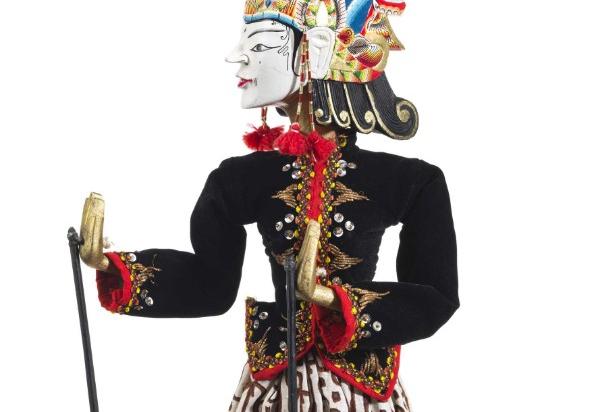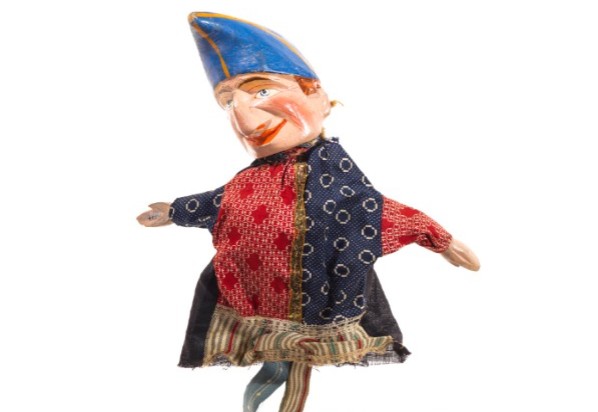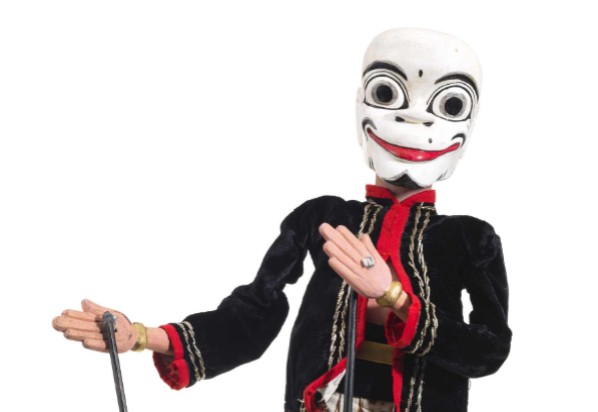
 Foto: Museum der Kulturen Baden
Foto: Museum der Kulturen BadenWith the exhibition “Bhima, Mr Punch, and the Demon”, the Museum der Kulturen Basel (MKB) steps into the epic world of puppet theatre and casts a spotlight on the fascinating puppets and marionettes that bring it to life.
Amir Hamzah was the uncle of the prophet Mohammed. He helped his father defend the Kingdom of Arabia; together they went on to overcome many challenges during the diffusion of Islam.
The rod puppet is one of the main figures in the menak narratives. The story cycle that focuses on Amir Hamzah is part of the traditional Indonesian wayang theatre. The wayang kulit shadow play theatre is on the UNESCO World Heritage list. On the island of Java, the rod puppet theatre is extremely popular, and puppeteers often enjoy superstar status.
 Foto: Museum der Kulturen Baden
Foto: Museum der Kulturen Baden
The figure of Amir Hamza was carved of wood in the Sentolo style by Widi Prayitno in 1974. It is part of the Gamper collection which was gifted to MKB in 2017. Curator Richard Kunz took the bestowal of roughly 2,500 objects as an occasion to plan for a major exhibition on the puppet theatre, not least because was able to draw on the large collection of puppets and figures held by MKB.
His selection fell on a host of beautiful rod and hand puppets, shadow play figures, and marionettes from Asia and Europe, many of them from the Gamper collection. Central to the show are scenes from a number of celebrated epics; these are enacted theatrically with the help of their main characters, always from the same type of figure theatre and the same region.
For one thing, we have Bhima from the ancient Indian Mahabharata epic. Together with his brothers, Bhima battles against his evil cousins. In their struggle, they are joined by deities and jesters. In the wayang theatre, the good guys are easy to recognize: they are usually light skinned, have straight noses, and almond-shaped eyes. Intriguingly, Bhima has round eyes and a large bulbous nose – otherwise features of evildoers and demons.
In the Indian Ramayana epic, visitors encounter Rama and Sita and their story of love, loyalty, and betrayal. Other figures include family members, malicious adversaries, and the monkey general Hanuman. The leather shadow play figures are from Andhra Pradesh and were acquired by MKB in 1964.
In “Journey to the West”, a Chinese classic, the main part is played by the monkey hero Sun Wukong who has supernatural powers. Other members of the cast include gods, Sun’s four companions, and a host of demons whom they encounter on their quest. All these wooden-headed hand puppets are from the Gamper collection.
 Foto: Museum der Kulturen Baden
Foto: Museum der Kulturen Baden
Apart from Mr Punch, the cast of the Punch and Judy show includes a grandmother, a crocodile, a policeman, a student, and the devil. The hand puppets from Thuringia in Germany were acquired by MKB in the 1970s. In the Turkish Karagöz theatre, centred on the main characters Karagöz and Hacivat, other figures include the Albanian, the opium addict, the dandy, the drunkard, the prostitute, and the dwarf Beberuhi, all made of animal skin. These figures, too, were purchased by MKB in the 1970s.
The strongly typified characters allow puppeteers not only to entertain their audiences but also to depict the world and society. Jesters and demons – characters that are part of every puppet theatre – receive special attention. In the universal struggle between good and evil, the demons always lose out against the good. On the one hand, jesters take on the role of clown-like entertainers and servants, on the other, they embody critical voices who hold up a mirror to their audiences, like, for example, Toples from the wayang menak theatre. Widni Prayitno had him made specially for Werner Gamper in 1980.
The exhibition opens on 22 August at 18.30, and continues until 2 August 2020.
Andrea Mašek, 22. 9. 2019
22. 1. 2026
Škrobotník, Šlundra, Šibrová
Shánění krávy – Deset obrazů hledajícího ducha
24. 1. 2026
Divadlo Lampion, Kladno
Slepičí letka
1. 1. 2026 – 14. 2. 2026
20 let činnosti Handa Gote
1. 1. 2026 – 31. 12. 2026
Rok loutkového divadla
16. 2. 2026 – 20. 2. 2026
MimiArt 2026
19. 2. 2026 – 28. 2. 2026
Malá inventura 2026
Ivan Balaďa (1. 1. 1936 – 17. 6. 2014)
František Sokol (2. 1. 1931 – 14. 10. 2017)
Vladimír Kubelka (7. 1. 1931)
Jiří Davídek (7. 1. 1936)
Zoja Mikotová (13. 1. 1951)
Marie Strnadová (22. 1. 1941)
Jan Dvořák (30. 1. 1951)
Jolana Brannyová (31. 1. 1966)
Alois Tománek (2. 8. 1942 – 19. 1. 2011)
Václav Poul (20. 8. 1951 – 14. 1. 2021)
Pavel Blatný (14. 9. 1931 – 20. 1. 2021)
This website is maintained by Sdružení pro vydávání časopisu Loutkář, Celetná 595/17 Prague, ID no.: 67363741. The content of this website is subject to copyright law and without consent of its owner may not be disseminated further. The owner does not accept any responsibility for the content of third-party websites linked from this site.
Twitter
RSS